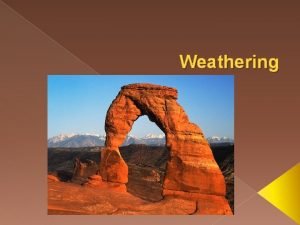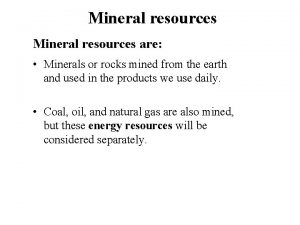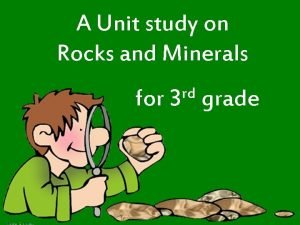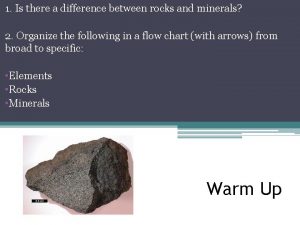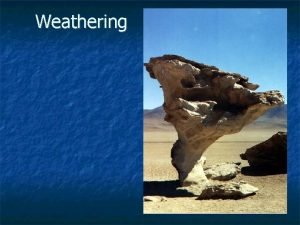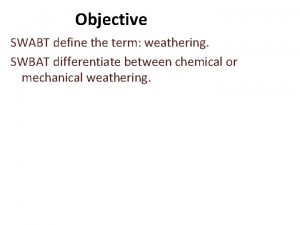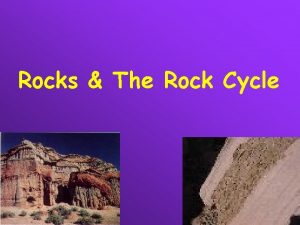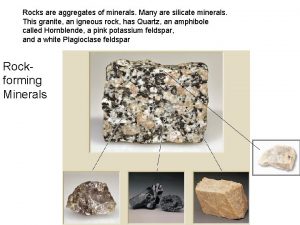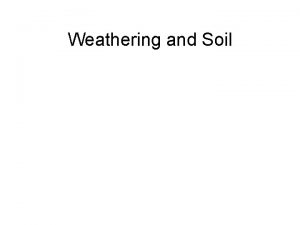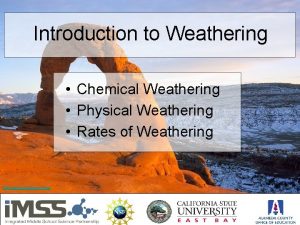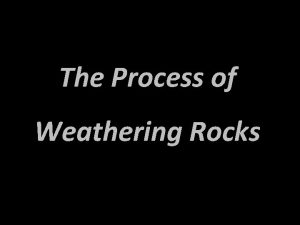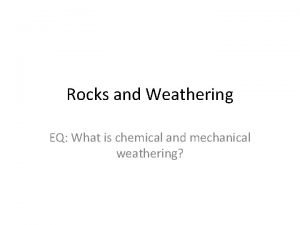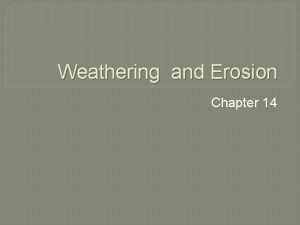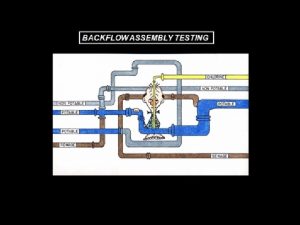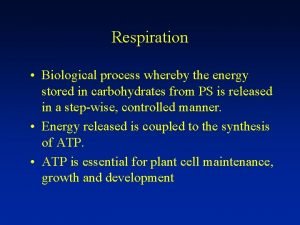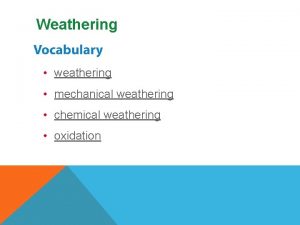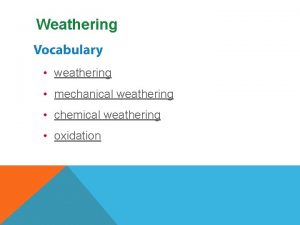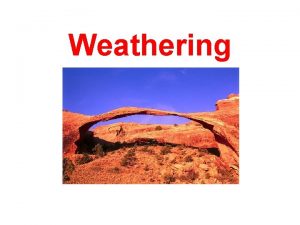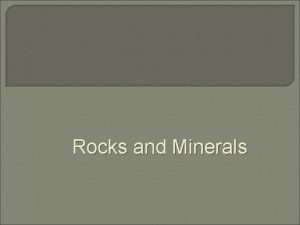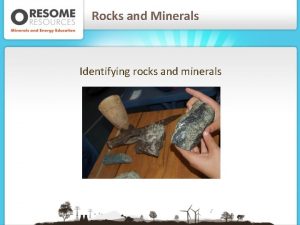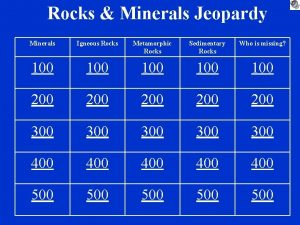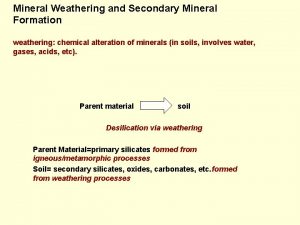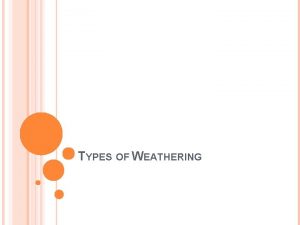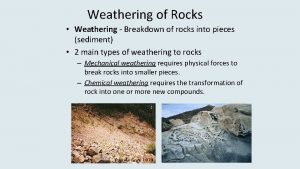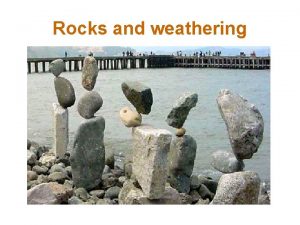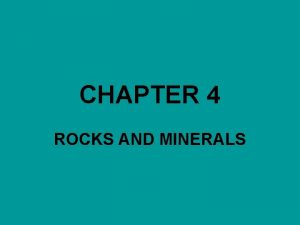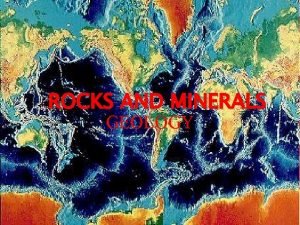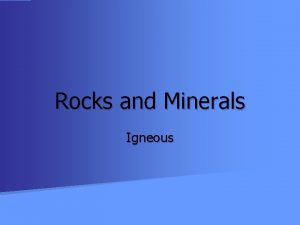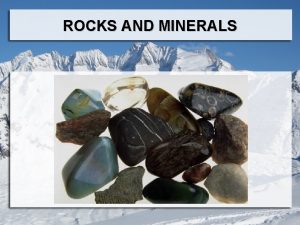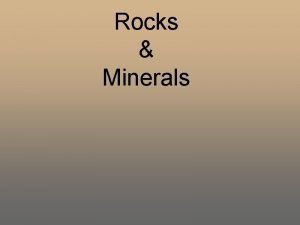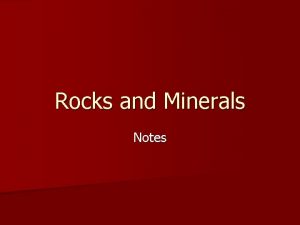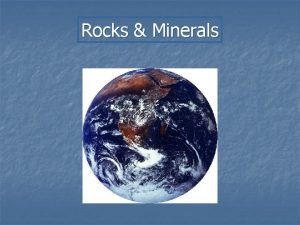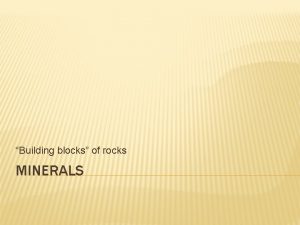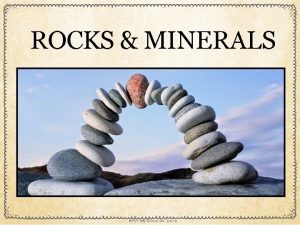Weathering Rocks and minerals Review Quartza mineral resistant


























- Slides: 26

Weathering

Rocks and minerals Review! � Quartz-a mineral resistant to mechanical and chemical weathering � Silicates-a strong “glue” that enables sedimentary rock to resist weathering � Sedimentary rocks that weather quickly contain calcite.

Rocks and minerals Review! � Most are deep within Earth’s crust formed under extreme conditions of temperature and pressure. � Rocks that are uplifted to the surface are exposed to gases and water in Earth’s atmosphere.

What is weathering? � the natural process by which atmospheric and environmental agents, such as wind, rain, and temperature changes, disintegrate and decompose rocks � Two types – › mechanical › chemical

Mechanical Weathering the process by which rocks break down into smaller pieces by physical means (also called physical weathering) �strictly a physical process and does not change the composition of the rock. �Common agents: ice, plants and animals, gravity, running water, and wind.

Mechanical - Ice Wedging �Agents: ice �occurs in cold climates when water seeps into the cracks in rock and freezes.

Mechanical - Abrasion � Agents: � the gravity, running water, and wind grinding and wearing away of rock surfaces through the mechanical action of other rock or sand particles

Mechanical - Organic Activity �Agents: plants and animals �As plants grow, the roots grow and expand to create pressure that wedge rock apart.

Mechanical - Organic Activity � Animals may burrow through rocks exposing new rock surfaces to weathering agents

Mechanical Weathering � Observe physical weathering

Chemical Weathering the process by which rocks break down as a result of chemical reactions (even granite can be broken down into sediment) �Chemical reactions commonly occur between rock, water, carbon dioxide, oxygen, acids, and bases. �changes both the composition and physical appearance of the rock.

Chemical – Oxidation the process by which an element combines with oxygen �Oxidation commonly occurs in rock that has iron-bearing minerals, such as hematite and magnetite.

Chemical - Hydrolysis a chemical reaction between water and another substance to form two or more new substances �Minerals that are affected by hydrolysis often dissolve in water – ex. Feldspars turn to clay �Water can then carry the dissolved minerals to lower layers of rock in a process called leaching.

Chemical - Hydrolysis

Chemical - Carbonation the conversion of a compound into a carbonate �Carbonic acid dissolves rocks composed of carbonate minerals

Chemical - Acids � Organic acids - produced naturally by certain living organisms such as lichens or mosses � Acid Precipitation - rain, sleet, or snow, that contains a high concentration of acids, often because of the pollution of the atmosphere (snow on buildings)

Chemical weathering � Chemical weathering of feldspar

Rates of Weathering �The processes of mechanical and chemical weathering generally work very slowly. �The rate at which rock weathers depends on a number of factors, including rock composition, climate, and topography.

Rates – Rock Composition � differential weathering the process by which softer, less weather resistant rocks wear away at a faster rate than harder, more weather resistant rocks do � For example – sandstone weathers slower than shale, why?

Rates – Surface Area � Surface Area – › The greater the surface area, the faster the weathering

Rates – Surface Area Fractures and Joints �Most rocks on Earth’s surface contain natural fractures and joints – natural zones of weakness �Fractures and joints increase the surface area of a rock and allow weathering to take place more rapidly.

Rates - Climate �In general, climates that have alternating periods of hot and cold weather allow the fastest rates of weathering. �Climates with more moisture result in a faster rate of weathering

Rates - Topography � Because temperatures are generally cold at high elevations, ice wedging is more common at high elevations than at low elevations. � On steep slopes, such as mountainsides, weathered rock fragments are pulled downhill by gravity and washed out by heavy rains. � As a result of the removal of these surface rocks, new surfaces of the mountain are continually exposed to weathering.

Rates - Human Activity �Mining and construction often expose rock surfaces to agents of weathering such as strong acids. �Recreational activities such as hiking or riding all-terrain vehicles can also speed up weathering

Rates - Plant and Animals �The roots of plants and trees often break apart rock. Burrowing animals dig holes into rock and soil. Both increase the rate of weathering.

Review � Play chemical and physical weathering
 Is quartza mineral
Is quartza mineral Is quartza mineral
Is quartza mineral Igneous vs sedimentary or metamorphic
Igneous vs sedimentary or metamorphic Igneous rock to metamorphic rock
Igneous rock to metamorphic rock Rock cycle song
Rock cycle song Rock cycle
Rock cycle Difference between minerals and rocks
Difference between minerals and rocks Metamorphic rocks concept map
Metamorphic rocks concept map Poem about minerals and rocks 3 stanza
Poem about minerals and rocks 3 stanza Whats the difference between rocks and minerals
Whats the difference between rocks and minerals Rock type
Rock type Mechanical and chemical weathering examples
Mechanical and chemical weathering examples Differentiate between physical and chemical weathering
Differentiate between physical and chemical weathering Quartzite rock cycle
Quartzite rock cycle Rocks are aggregates of minerals
Rocks are aggregates of minerals Extrusive rocks and intrusive rocks
Extrusive rocks and intrusive rocks Granite diorite gabbro
Granite diorite gabbro What is weathering explain the types of weathering
What is weathering explain the types of weathering What cause physical weathering
What cause physical weathering Carbonation rock
Carbonation rock What is a subaerial process
What is a subaerial process Weathering rocks
Weathering rocks What are the two types of weathering
What are the two types of weathering Chapter 14 weathering and erosion review answers
Chapter 14 weathering and erosion review answers Spill resistant vacuum breaker
Spill resistant vacuum breaker Cyanide-resistant respiration slideshare
Cyanide-resistant respiration slideshare Resistant materials tools
Resistant materials tools
